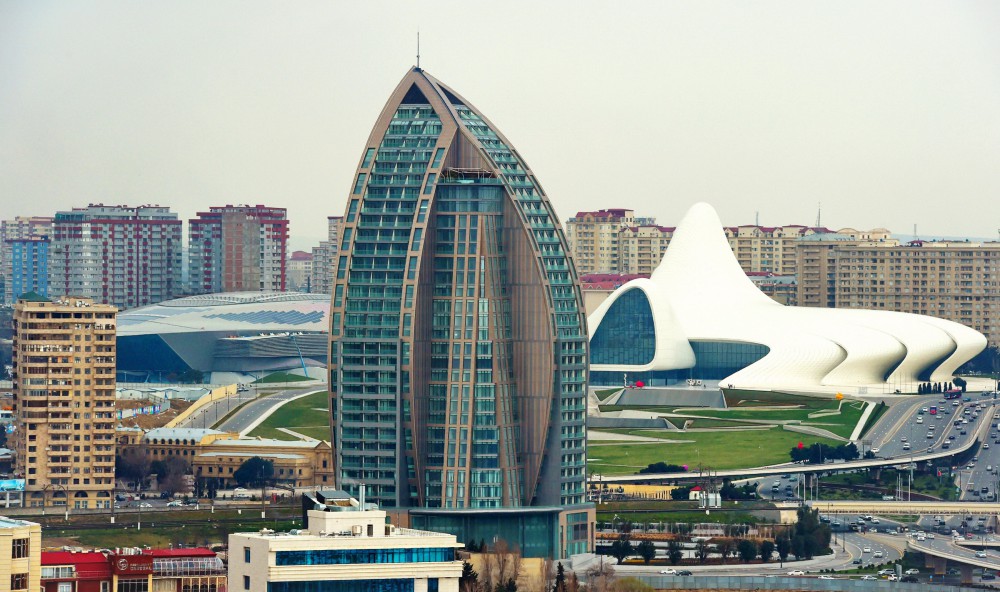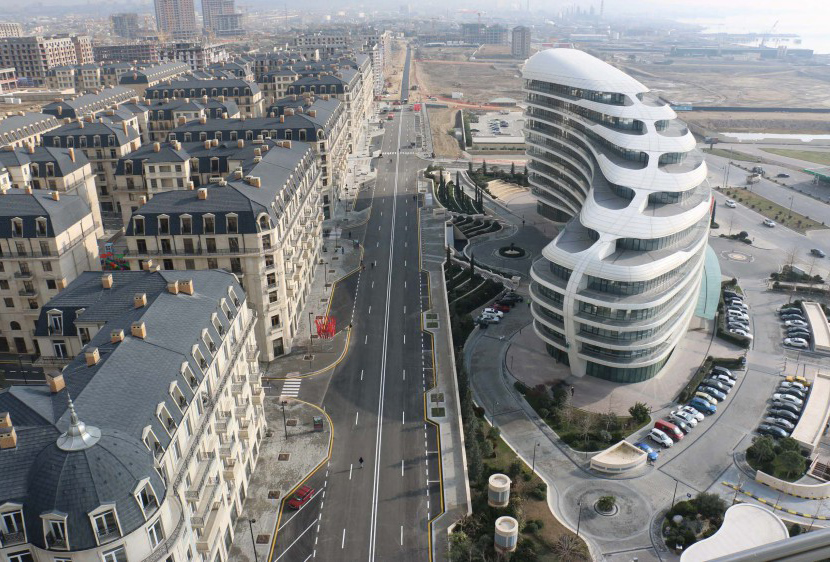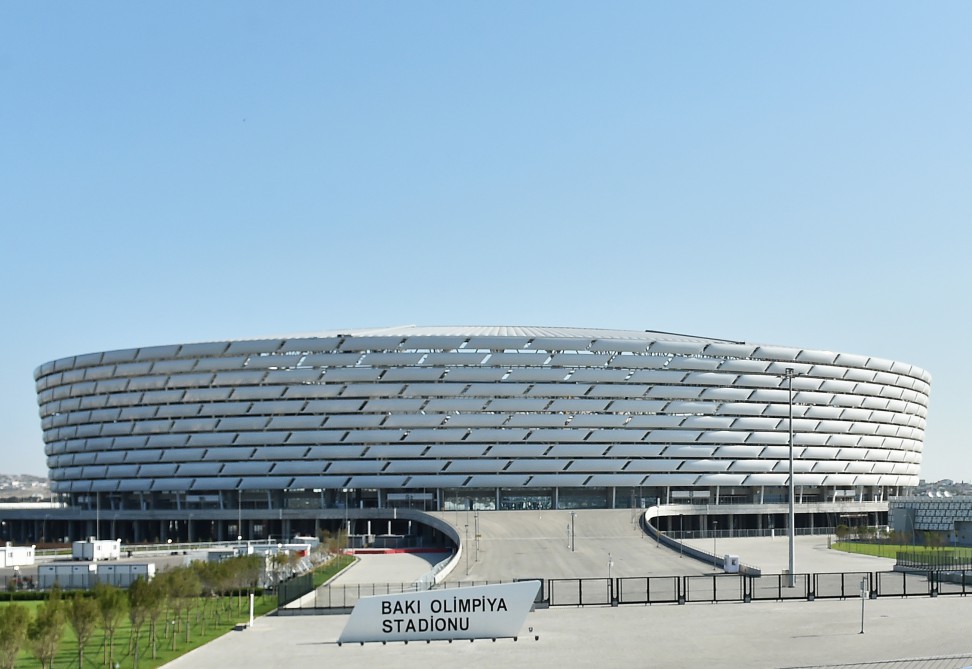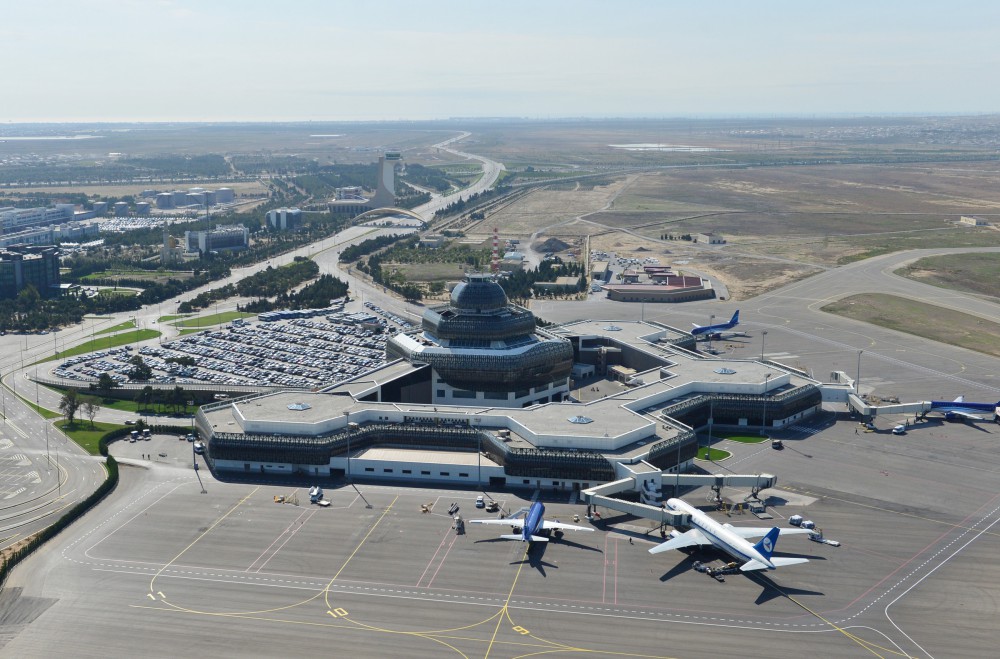The period of independence
After achieving independence in 1991, Baku as the capital of the country, as well as the rest of Azerbaijan, faced a number of difficulties and often very complex problems in its development, both for subjective and objective reasons. Fighting for its territorial integrity, independent Azerbaijan was also forced to address a number of very difficult problems caused by the military aggression of neighboring Armenia, which occupied one-fifth of its territory. And the most difficult questions were related to the addressing of the domestic and before everything else, the housing problems of over a million refugees who were forced to flee their homes and had lost almost everything during the Nagorno-Karabakh conflict.

At the beginning of 90s, it was very difficult to solve the problems of Baku under the conditions of internal political instability and the economic problems of the transition period.
Because of the concentration of almost all industrial potential of the country in Baku and the severance of economic ties with a number of former republics of the Soviet Union, many of the factories in Baku today became practically idle, which in turn naturally gave rise to a number of social problems. Economic problems of the transition period also affected a significant portion of the scientific institutions, higher and secondary specialized educational institutions, as well as the major medical and cultural institutions located in Baku.
Yet another issue in Baku, related to the independence of the country, was the appearance of many foreign embassies, as well as various representative offices of international organizations, multinational corporations, companies and firms, creation of infrastructure and construction of residential houses for their employees.
However, the return to the leadership of the country and election as president in nationwide elections in 1993, of an outstanding political figure Heydar Aliyev, allowed the stabilization of the political situation within a short period of time and attracted foreign investment from major international oil companies for the development of the country. A significant event of this kind was the signing of a “Large oil contract”, also referred to as “the Contract of the Century”, which allowed the execution of some specific tasks, including those related to urban development and construction in the capital of Azerbaijan – Baku.

Baku’s architecture is being improved with the construction of highly comfortable apartment buildings, modern hotel complexes meeting the highest world standards, large supermarkets, bank buildings, offices, etc. And it should be noted that because of their location, architectural forms, number of floors and the color scheme, these buildings often play a very active formative role in the creation of the modern face of the city. Currently, internationally renowned construction companies from around the world work successfully in Baku.
Baku plays a very important role in the realization of the so-called “Silk Road of the XXI century” within the framework of the international transport and communication programs.
In 2006, the Baku-Tbilisi-Ceyhan Main Export Pipeline was exploited. The Baku-Tbilisi-Kars railway, which starts its operation on October 30, 2007, provided the connection of the Trans-Asia and Trans-Europe railways.
The transition of Azerbaijan from a planned socialist economy to a free market also influenced the planning process of its development. And above all, “General Plan for economic and social development of Baku until 2005” was approved in 1986. The general plan of Baku city, as the previous ones, foresaw Absheron peninsula as a single national economy complex. However, the implementation of this plan didn’t realized at all. In 2004-2005, the park in front of the Heydar Aliyev Palace was reconstructed and a monument to national leader Heydar Aliyev was erected in in the center of the park (sculptor M. Nogin, architectures I. Voskresenski and S. Sherbakov).
In 70s-80s years of XX century, the process of the creation of green areas in the city reached a level never seen before. Moreover, the current process of the greening should include not only the historical center of the city, but also its new districts. The establishment of the park after Heydar Aliyev in Nizami district, expansion of “Winter boulevard” in the city center and greening in the National Seaside Park, realization of reconstruction works and landscaping in a 23-hectare area in “Sovetski”, the foundation of reconstruction of new recreation parks in different parts of the city serves the beautification of Baku.

New realities have given birth to the new conditions for the development of our city. In particular, a need arouse for speedy modernization of the central industrial zones, including an old industrial area, the so-called “Black city” and the construction of a residential complex “White city”.
In recent years many administrative, public and residential buildings, which are interesting in design, modern in form and at the same time, include many features of the national traditions have been constructed in Baku and the construction of such buildings is still underway. Construction of an architectural-memorial complex “Eternal Flame”, located in aplace sacred for every citizen of the country – “Alley of Martyrs”, deverves a special mention. This copmlex contains all the best traits of the traditional memorial architecture of Azerbaijan.
After years of prohibition, a number of buildings dedicated to religious purposes are being constructed for the first time in Baku. Religious-memorial complexes “Bibi Heybet” and “Taza Pir” were restored, the Heydar mosque was built, an opening of new building of Haji Javad mosque was held. A whole series of mosques in different parts of the city were built, including the new residential districts.
In spite of, Azerbaijan is still practically in a state of war with armenia, it became possible to realize such grantd projects like the international railway route of Baku-Tbilisi-Kars and the building of major water supply line Gabala-Baku, as well as the execution of large scale improvement projects of the towns and villages of the the country, reorganization of the roads and creation of new transport infrastructure, constructions of schools and hospitals.

Within a short period of time, designers of our own, as well as the leading international architects, such as Zaha Hadid, Jean Nouvel, Norman Foster and others have been realized in large scale projects such as Heydar Aliyev Center, National Flag Square, Baku Olympic Stadium Flame Towers hotel and business center, Chrystal Hall concert complex, large hotel complexes “Marriot Absheron”, “Hilton of Baku”, “Four Seasons”, “Kempinski Badamdar”, and other such buildings and structures.
Because of the demands of our day, a large-scale renewal of the city centeris taking place – new structures are being built and the older ones are being renovated. In many districts of Baku there are ongoing works of modernization of the city transportation system, renewal of the decayed communication facilities, beautification works and creation of green zones.
In 2010, the State Flag Square and its museum were opened in boulevard.
Popular recreation spot of the city’s inhabitants, the seaside boulevard, has gone through a total renovation. Nowadays, parks in varoius parts of Baku have own infrastructure, many cafes, restaurants, amusement and playgrounds for children. In the years of independence, a lot of parks and recreation complexes, such as Park of Officers, Philharmonia Garden, Khagani Garden, Highland Park, Dede Gorgud Park, Sports and entertainment park complex in Khatai district, the fountain complex “Swan” were built and reconstructed in Baku. The International Mugham Center, the Carpet Museum, the Baku Sport Palace , Baku Crystall Hall, “Little Venice” small town and the Stone Annals Museum are located in the Seaside Boulevard.
Baku has also turned into a center of international events. In 2012, it was the capital of the popular international song contest Eurovision. In 2015, Baku hosted the first Europen Olympic Games and in 2017 the fourth Islamic Solidarity Games. the National Gymnastic Arena, the Aquatic Palace and the Baku Shooting Center were also constructed for the European Games. More than 20 museums and art galleries are operating in Baku nowadays.

The current metro lines of 36,63 km length, consist of 25 stations on 3 lines, an electrical depot and technological corps (building) where the administrative apparatus is located as well. Conceptual Development Scheme envisages the staged expansion of the existing network by 2030 and the creation of a giant subway network, which with 2 existing and 3 additionally new lines mean a metro network of 5 lines, 76 stations and 119 km of subway lines.
The relocation of the industrial zone of Baku, including the Baku International Sea Trade Port to Alat settlement of Garadagh and foundation of a Free Trade Zone will play an important role in further development of Baku. Great changes will be realized in Baku in near future. The Baku Regional Development Plan for the period up to 2030 has been worked out. According to the plan, the new Baku urban agglomeration will connect the city with Absheron region an Sumgayit city and will envisages the whole Absheron Peninsula and its suburbs.
Today, Baku is being developed in the unity of modernity and unique architectural tradition.
References used:
Dadashova S., Gasimzade E., Mammadov G., Baku - the pages of the history. Union of Architects of Azerbaijan Republic. Added and updated second edition. - Baku: Sharg-Garb, 2013. (in the azerbaijani language)
Azerbaijan National Encyclopedia. The third volume. Baku: The Azerbaijan National Encyclopedia Scientific Center, 2011, “Baku” article. (in the azerbaijani language)
Azerbaijan National Encyclopedia. Azerbaijan. Baku: The Azerbaijan National Encyclopedia Scientific Center, 2007, “Architecture” article. (in the azerbaijani language)
